
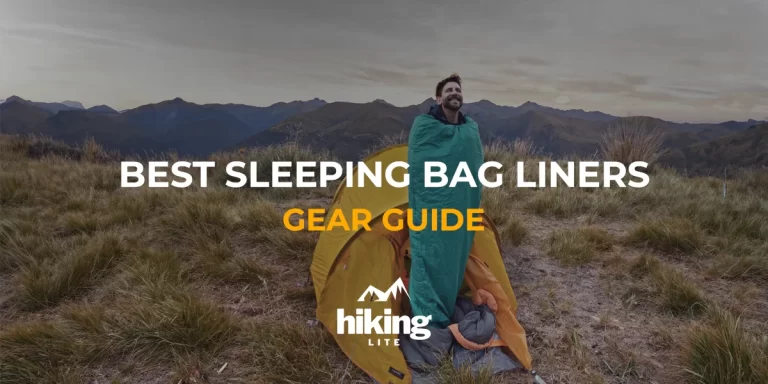
Getting a good night’s sleep while backpacking is important for having fun. But there are a lot of sleeping bag liner options to choose from. You need to think about what they are made of, weight, and warmth.
This guide looks at best sleeping bag liners based on tests. We tried different liners that got good reviews. From those, we picked the five best ones.
Whether you get too hot or need more warmth, one of these liners will feel nice while you sleep under the stars.
By considering how you sleep and the liner qualities, our list can help you pick the perfect one. Let’s get started.
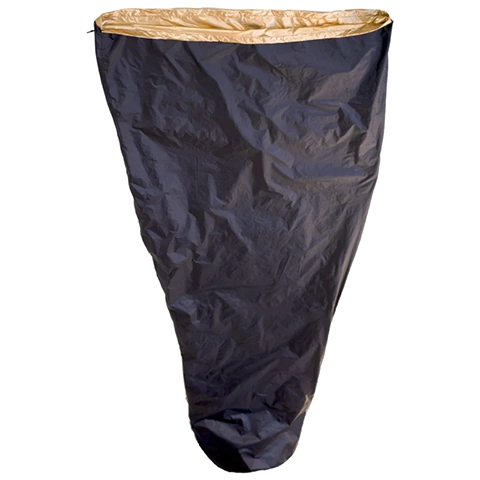
Key Specs
Weight: 3.74 ounces (106 grams)
Material: nylon
Price: $$$
PROS
✅ Ultralight
✅ Small pack size
CONS
❌ Relatively expensive
❌ Not for light 3-season use
As the essential final layer for technical winter expeditions, the Hot Sac exceeds at its intended purpose.
Constructed from a lightweight yet durable ripstop nylon with a proprietary reflective coating, it keeps valuable heat from escaping the sleeping bag.
During testing in sub-freezing temperatures, I found it tremendously boosted warmth and allowing comfortable sleeping without excessive sweat buildup thanks to its vapor barrier properties.
The elasticized hood and non-porous fabric provided cozy, draft-free shelter for my head and torso.
At a mere 3.74 ounces, its compressibility was impressive. While lacking breathability for 3-season use as expected from its vapor barrier function, this is easily remedied by layering or using it interior to breathable liners in milder weather.
For protecting valuable core heat on wintry adventures, the Hot Sac delivers exceptional value. Though not fully taped, well-constructed seams held reliably.
Overall it earns top marks for maximizing function in technical sleeping systems. An prudent investment for serious cold-weather pursuits.

Key Specs
Weight: 9.8 ounces (278 grams)
Material: 140 gsm merino wool
Price: $$$
PROS
✅ Extremely versatile
✅ High quality
CONS
❌ Relatively heavy
I recently tested the Zpacks Merino Wool Sleeping Bag Liner during a 5-day backpacking trip in the High Sierras. I paired it with a lightweight quilt to improve temperature regulation.
Made from ultra-soft Gostwyck Merino wool, the liner felt great against my skin without being clingy or leaving me damp like synthetics sometimes can. Its stretchy fit conformed well without feeling restrictive.
The merino fabric naturally wicked away moisture without absorbing odors from my body. This meant my sleeping quilt stayed fresher for longer.
While a little heavier and costlier than basic polyester liners, the wool liner is extremely versatile. On future trips, I plan to use it on its own on warmer nights.
Overall, the material and build quality of the Zpacks liner lived up to the price. For thru-hikers and backpackers wanting maximum next-to-skin comfort from a natural fiber, this is a great choice.
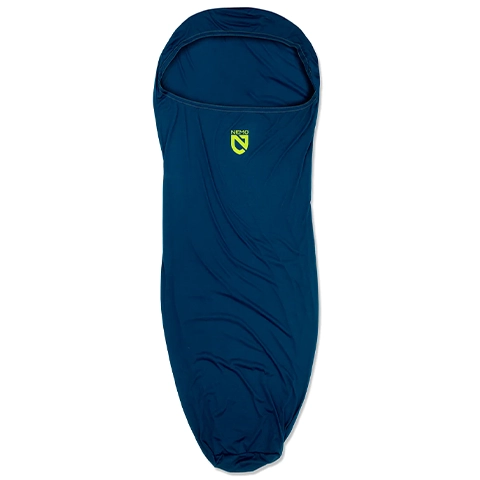
Key Specs
Weight: 8.25 ounces (234 grams)
Material: polyester fiber
Price: $
PROS
✅ Relatively affordable
✅ Great Warranty
CONS
❌ Relatively heavy
As a restless sleeper, I was impressed with how the Nemo Tracer liner allowed unrestricted movement without binding.
Made from ecologically-minded Thermolite EcoMade fabric, it effectively trapped my body heat to extend the usable temperature range of my sleeping bag.
The antimicrobial Polygiene treatment keeping odors and bacteria at bay, allowing for less frequent cleaning of my sleep system. This saves water and extends the lifespan of technical fabrics over time.
While not the lightest option at 8.25oz, the Tracer brings valuable functions for comfortable outdoor slumber. Its engineered Spoon shape properly cradled my body regardless of position.
For dedicated backpackers protecting sleep essentials, this liner offers great value.
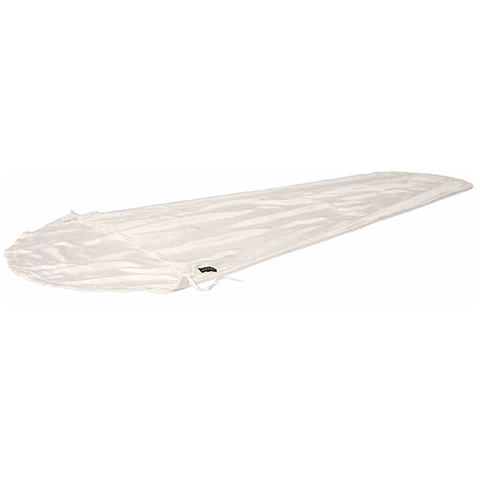
Key Specs
Weight: 4.09 ounces (116 grams)
Material: silk
Price: $$
PROS
✅ High quality
✅ Small pack size
CONS
❌ A bit fragile
The Cocoon Silk Mummy Liner provides various benefits for backpackers seeking maximum versatility from their sleep system. As a protective layer, it keeps pricier bags clean during extended trips.
Its breathable weave promotes cooling in warmer weather, making it usable as a standalone bag when temperatures rise. And its tight weave traps heat, providing up to 8.4°F additional warmth for colder seasons.
At just 4.09 ounces, the silk liner compresses small without bulk. However, some reports note concerns over silk’s durability – careful handling is a must.
Additionally, its full-coverage mummy shape proved challenging to orient inside my hammock without markers. Some fittings could ease entry/exit.
With cautious use, it performs well for its compact size.
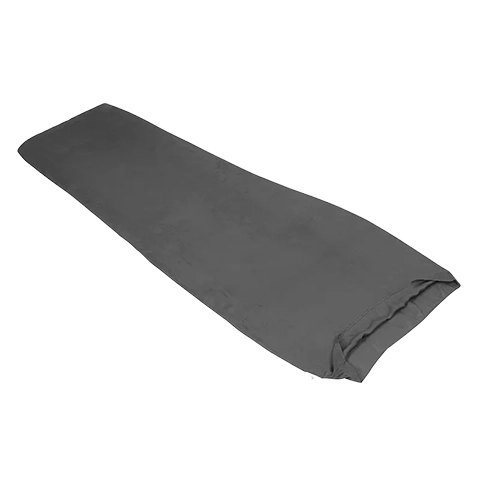
Key Specs
Weight: 11.99 ounces (340 grams)
Material: cotton
Price: $
PROS
✅ Relatively affordable
✅ Great quality material
CONS
❌ Not for really tall people
After trying out different materials, I found that the RAB Cotton Ascent liner is just right. It’s made of a strong mix of cotton and polyester, so it feels nice on your skin but isn’t too warm or delicate like silk.
It weighs about 12 ounces, which adds some weight to my backpack, but it keeps your sleeping bag safe from sweat and oils. Its shape fits snugly around your body without feeling too tight.
While it might not be the warmest option out there, the cotton liner is comfy in lots of different weather. It kept me cozy on trips where the temperature changed a lot overnight.
And the best part? It’s not expensive, but it’s still tough enough to last for years of regular use. So, even though it’s not super lightweight, it’s a smart choice for backpackers who want comfort that lasts.
Picking the right sleeping bag liner is crucial for a comfortable outdoor adventure. In total, there are five types of sleeping bag liners.
Your selection should be guided by the prevailing weather conditions (particularly the time of year), the weight of your backpack, and your personal comfort preferences.
If you’re looking to become an expert on this topic, don’t forget to explore our in-depth post for a more comprehensive understanding of choosing the perfect sleeping bag liner.
When selecting the ideal sleeping bag liner, consider factors like hygienic properties, sheet weight and packability, washability, and durability. Opt for a liner made from breathable, moisture-wicking fabrics that are resistant to dirt and odors for hygienic protection. A portable, lightweight liner that compacts small yet provides warmth is best for backpacking. Look for a machine-washable liner that dries quickly and retains its form, offering continued protection. Together, these qualities—hygienic, portable, washable, and durable materials—will ensure a liner that keeps sleep systems clean and comfortable on hiking and camping trips.
Sleeping bag liners have several benefits for backpackers. They help keep your sleeping bag clean so it lasts longer. Sweat and oils from your skin can hurt the bag over time. But a liner protects it. Liners also make your bag more comfortable. They add a layer between you and your bag so the material isn’t right on your skin. And liners give you more warmth. They trap another layer of warm air between you and your bag. Some liners add several degrees of warmth. Liners make getting in and out of your sleeping bag easier too since you don’t have to touch the bag material. Overall, liners help you stay warmer and more comfortable while keeping your expensive sleeping bag in good shape for longer.
Sleeping bag liners are pretty versatile and can work with most sleeping bags. They are designed to easily fit inside practically any style of sleeping bag. Whether you have a mummy, semi-rectangular, or rectangular bag, a liner will slip in without issue. The only type it may not work great for is an ultra-thin emergency bag since there may not be enough extra room. As long as your bag isn’t too small for your size, any liner should fit inside. They are also meant to work for all seasons bags from summer to winter ratings. So in general, you can feel free to use a liner with whatever type of sleeping bag you already own without worry as long as it’s not an extremely tight fit inside.